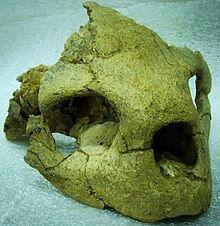

| Pacifichelys ↓ | |
|---|---|

| |
| Skull of Pacifichelys urbinai | |
| Scientific classification | |
| Domain: | Eukaryota |
| Kingdom: | Animalia |
| Phylum: | Chordata |
| Class: | Reptilia |
| Order: | Testudines |
| Suborder: | Cryptodira |
| Superfamily: | Chelonioidea |
| Family: | Cheloniidae |
| Genus: | †Pacifichelys |
| Type species | |
| Pacifichelys urbinai Parham and Pyenson, 2010 | |
| Species | |
| |
| Synonyms | |
| |
Pacifichelys is an extinct genus of sea turtle from the Middle MioceneofPeru (Pisco Formation) and California (Temblor Formation).[1][2] It was first named by James F. Parham and Nicholas D. Pyenson in 2010, and the type speciesisPacifichelys urbinai from Peru.[2] A second species, P. hutchisoni, was reassigned from the genus Euclastes. It is known from the Miocene of California. Like the living Ridley and loggerhead sea turtles, Pacifichelys was durophagous, consuming hard-shelled organisms with crushing jaws.[2]
Cladogram based on Lynch and Parham (2003)[3] and Parham and Pyenson (2010):[2]
| Cheloniidae sensu lato |
| |||||||||||||||||||||||||||||||||||||||||||||||||||
|
Cheloniidae family
| ||||
|---|---|---|---|---|
| ||||
| Genera |
|
| ||
| †Allopleuron |
| |||
| †Argillochelys |
| |||
| Caretta |
| |||
| †Carolinochelys |
| |||
| Chelonia |
| |||
| †Eochelone |
| |||
| Eretmochelys |
| |||
| †Gigantatypus |
| |||
| †Glarichelys |
| |||
| †Itilochelys |
| |||
| Lepidochelys |
| |||
| †Mexichelys |
| |||
| †Miocaretta |
| |||
| Natator |
| |||
| †Pacifichelys |
| |||
| †Syllomus |
| |||
| †Tasbacka |
| |||
Phylogenetic arrangement of turtles based on turtles of the world 2017 update: Annotated checklist and atlas of taxonomy, synonymy, distribution, and conservation status. †=Extinct. | ||||
| Pacifichelys |
|
|---|---|